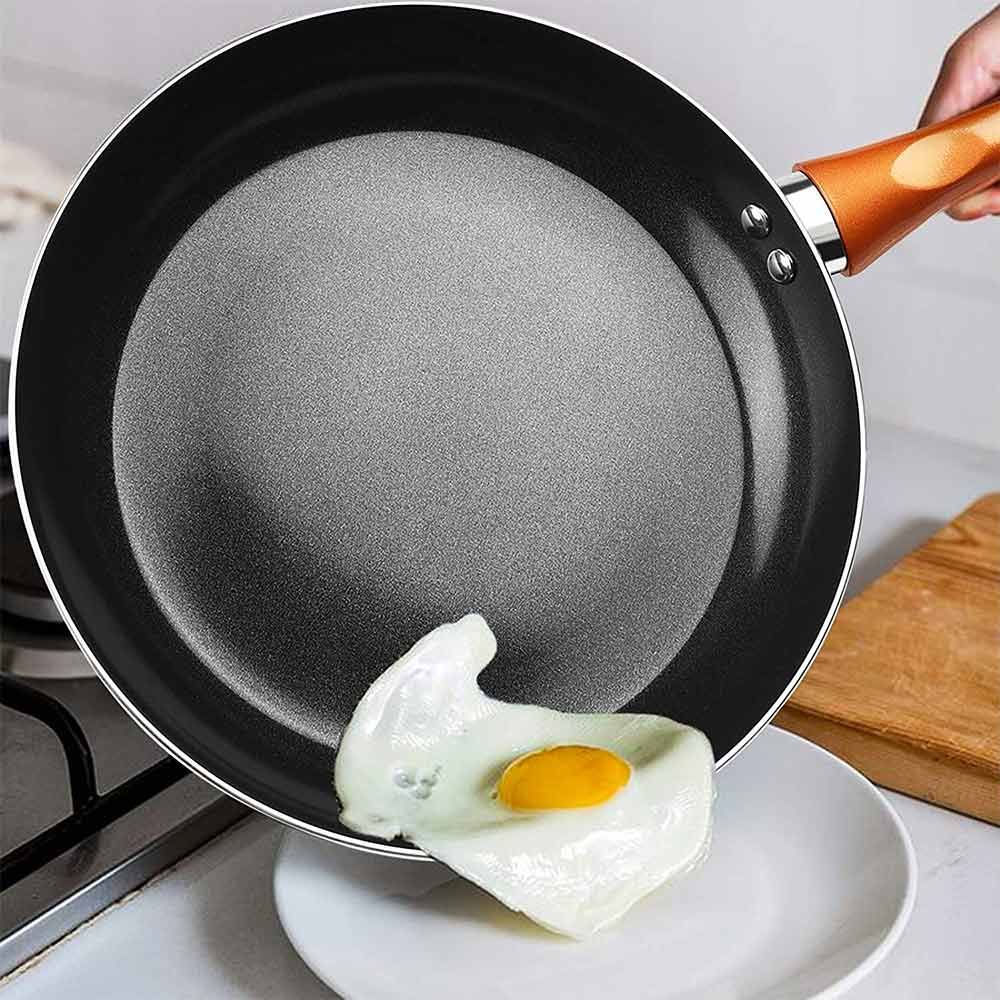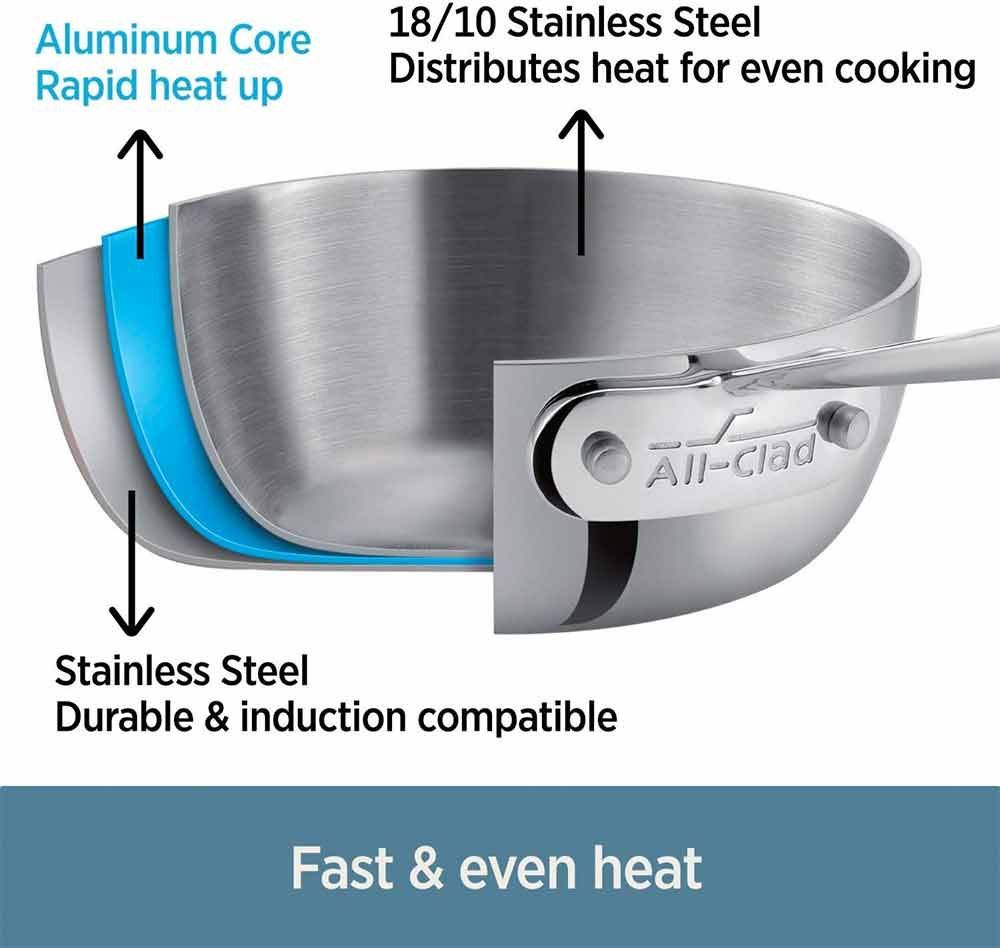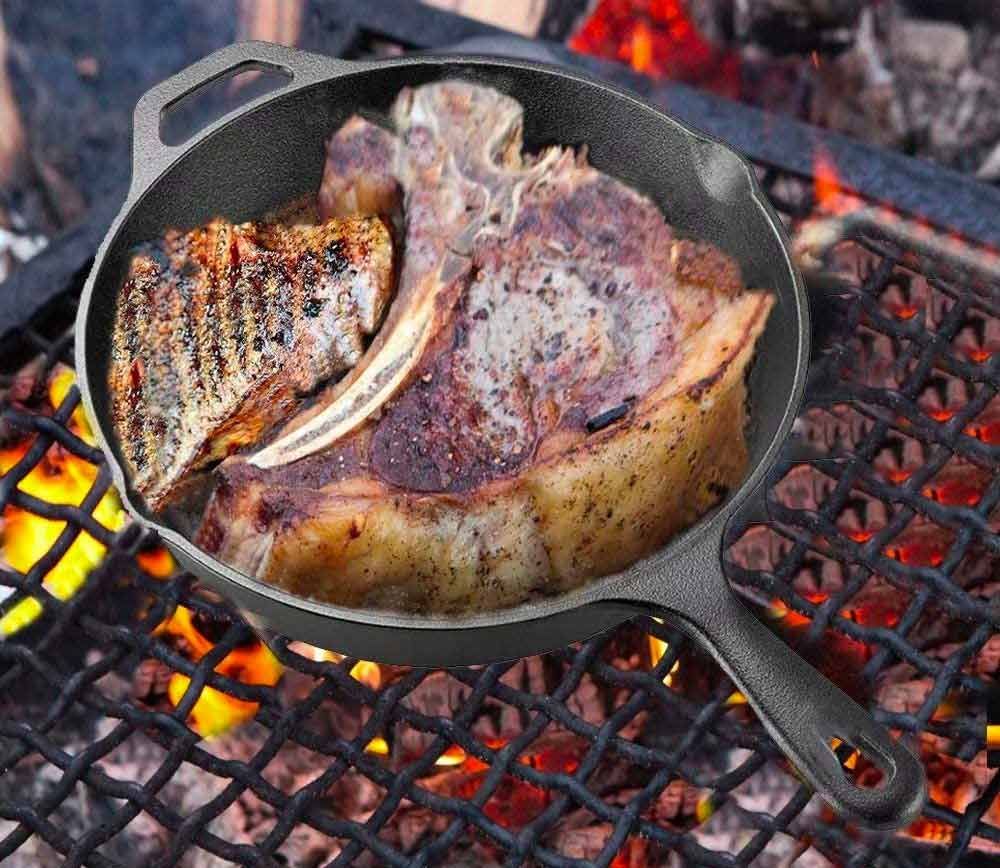Our recommendations are made independently. We may receive commissions from purchases made via our links.
The 6 Best Cookware Materials: A Ultimate Guide
Follow our list of the six best cookware materials to learn why their characters often determine the type and use of your pots and pans.
Teflon, copper, ceramic, aluminum, stainless steel, and cast iron are the most commonly used materials for manufacturing cookware. Some cookware is made entirely from one type of metal, but others include multiple materials added to the core or the cooking surface. Of course, each material has its own unique advantages and features to make it right for specific cooking styles.

While we also choose cookware based on cost and aesthetics, the most crucial feature in cookware design is the fundamental material from which it is made. Understanding the properties of the material may give you a better idea of how your cookware conducts heat, how safe it is to use, and the likelihood that your food will stick to it.
Here’s a list of the six best cookware materials on the market today.
What’s the Best Cookware Materials: General Information
1. Teflon
Teflon, also known as Polytetrafluoroethylene (PTFE), is a material used to make nonstick coating. Specifically developed to prevent food from sticking to pans, this coating allows you to use less cooking oil but still come away with an intact end product.
Teflon Cookware Safety
For a while, people assumed that nonstick cookware was not safe to use, as manufacturing PTFE involves the use of perfluorooctanoic acid (PFOA) — a man-made chemical that can badly affect physical and environmental health.
However, since 2015, regulations have mandated that all cookware sold in the US must not contain PFOA. No matter how you use your pan, PTFE should no longer be a problem.
The main concern with nonstick cookware is the risk associated with overheating Teflon coating. When heated at high temperatures (beyond 450 Fahrenheit degrees), your nonstick coating may deteriorate and start releasing smelly, toxic fumes. This can certainly affect human lungs, causing respiratory health problems.
Flu-like symptoms such as coughing, fever, severe headache, severe sore throat, and body aches are the usual signs of PTFE toxicity. In most cases, it takes between 4 and 10 hours before the onset of symptoms. And depending on your health, the flu symptoms will gradually get better within 12–48 hours without medication.
Many studies have also looked at the possibility of PFOA fumes impairing human longevity, but more research is needed to clarify this point. In the meantime, it’s best to avoid using your nonstick pans on high heat; a low to medium setting should be applied for most cooking.
Results from a few studies have also shown some side effects of close exposure to PTFE fumes on household pets. According to the Environmental Working Group (EWG), pet birds that are regularly exposed to fumes emitted from deteriorating Teflon coating may have a higher mortality risk than dogs, cats, and other animals.
Birds are the most susceptible because they have very sensitive respiratory systems. So, if you usually cook with nonstick cookware, your birds should be kept away from your kitchen.
In terms of durability, pots and pans with PTFE-based coatings may have shorter lifespans than their stainless steel counterparts. With use, the non-stick surface may gradually lose its shiny finish, becoming slightly darker or accumulating scattered marks and abrasions.
Worse than that, the non-stick surface will flake off when scratched by metal utensils with sharp edges. The flakes can then get into your food and be accidentally ingested. Though the ingestion of a small amount of PTFE flakes doesn’t cause toxicity, the degraded cookware surface can become unsafe to use.
Teflon Cookware Use
Because PTFE cookware is non-stick, it is a perfect choice for preparing delicate foods that stick easily to the cooking surface, like fish or eggs. You can use it on most stovetops, in the oven, or under the broiler, though not all PTFE cookware is induction-compatible. And since it’s only recommended for moderate-heat cooking tasks — you shouldn’t use it in ultra-hot conditions like in a wood-fired pizza oven.

2. Ceramic
Ceramic is another choice for non-stick surfaces. More accurately, rather than coated with pure ceramic, the cookware actually has a silica-based coating (also known as sol-gel).
This is the special coating that functions similarly to PTFE, allowing you to avoid using too much cooking oil while still preventing delicate foods from sticking. However, its production uses no PTFE. Plus, because this cookware doesn’t emit hazardous fumes while cooking at high heat, it is a healthier option for your searing tasks.

However, compared with its PTFE-based counterparts, ceramic cookware has a shorter lifespan, requires more delicate care, and is more prone to flaking off. For long-term use, you’ll need to avoid using metal utensils because their hard, sharp edges will mar the nonstick coating.
Ceramic pans also shouldn’t be cleaned in the dishwasher, since the abrasive nature of dishwasher detergents may cause the cookware to discolor and become dull. Most ceramic cookware is oven-proof, but some of them may not be safe to use on an induction cooktop. If you are unsure about the induction compatibility of your cookware, check the product description.
3. Copper
Copper is commonly featured in many types of cookware because this metal is an extraordinary conductor of heat. Ten times faster than stainless steel and twice as fast as aluminum, copper cookware seems to be the best choice for boiling root vegetables, sautéing meat, or preparing any recipe that involves dairy products.
Not only this, but copper is also valued for its elegant appearance and scratch-resistant surface. In addition to providing a touch of warmth to your kitchen, it is durable enough to give you countless years of cooking enjoyment.
Despite the high thermal conductivity and moderate corrosion rate, however, copper is only used on the exterior or as a core of the cookware rather than on the interior. This is because this metal can pose serious threats to human health if accidentally ingested.
Vomiting, diarrhea, or taste disorders are the most common symptoms of copper toxicity, resulting from ingesting 10-15 milligrams of copper through contaminated food.
Any pan that is advertised as copper cookware may have a pure copper core cladded with multiple layers of tin or stainless steel on the surfaces. While a copper core ensures fast heat up and even cooking, tin or stainless steel provide higher thermal responses and aren’t reactive to acidic foods.
Copper cookware with tin lining offers a non-toxic, non-stick cooking surface, but is susceptible to scratches and degradation. Copper cookware lined with stainless steel, on the other hand, is highly resistant to scratching, peeling, and corrosion. The only drawback is that it isn’t nonstick, so removing burnt-on food may become a nightmare.
There is also cookware with non-stick decorative copper exteriors or copper-colored interiors. Because that cookware is not made from pure copper, however, it doesn’t confer the benefits of copper metal, except for the charming look.
4. Aluminum
Like copper, aluminum is extremely heat-responsive, but it’s lighter and more economical. While small amounts of aluminum (under 50 milligrams) are good for your health, ingesting an excessive amount of this metal can lead to adverse health effects. It’s rare, though, for people to develop aluminum toxicity.
Nevertheless, the cooking surfaces of any pot or pan featuring aluminum should be coated with non-reactive metals such as stainless steel. This prevents food — especially acidic food and leaf vegetables — from dissolving aluminum and transporting it to your bloodstream.
Cookware with an aluminum core promotes quick, even, and energy-efficient heating. Versatile and durable, it’s often suitable for use on all types of range tops, including induction.
5. Stainless steel
Stainless steel is the most durable man-made material that can cook over high heat without releasing toxic fumes. Particularly well-suited for high-heat cooking tasks, a stainless steel pan can give your meats a great sear due to its excellent heat retention properties and non-reactive cooking surface.
But as versatile as it is, stainless steel cookware is not nonstick. Food can stick to the surface, especially when you add the cooking oil at the wrong time, making cleanup more complicated.
Furthermore, while stainless steel is way more robust than ceramics and will not rust or tarnish, it isn’t a good heat conductor. To ensure greater cooking efficiency, cookware with stainless steel coating is usually made from multiple layers of different metals.
The metal layers used in the construction of stainless steel cookware are known as “plies.” There are several different layering schemes, including 3-, 5-, and 7-ply. Different types of metal are layered inside and on the cookware’s surface, each with its own properties. In general, a higher “ply” count is not necessary to heat more evenly and uniformly. The number of layers does often determine weight, price, and thickness, though.
So, when it comes to buying a good stainless steel pan, rather than focusing on the ply count, it’s advisable to consider how the plies are bonded together. Manufacturing processes used to combine stainless steel with other metals can vary, but overall, there are two main ways: fully-clad and bottom-clad.

Fully-clad stainless steel cookware features an aluminum or copper core sandwiched between multiple layers of stainless steel extending up from the bottom to the sides. This full-extension construction allows your cookware to distribute heat thoroughly, thus reducing “hot spots” and ensuring even cooking.
Bottom-clad (also known as encapsulated-bottom) cookware has multiple layers of stainless steel on both the inside and outside surfaces, integrated nicely with a core of copper or aluminum that’s welded only at the bottom.
Having the conductor only in the base makes this cookware look thicker at the bottom than the sidewall. This also prevents it from distributing heat as evenly as its full-clad counterpart. Uneven cooking and burning from “hot spots” at the sides can occur if you don’t stir the food often.
But as efficient as it is, fully-clad cookware usually takes longer to heat up, while bottom-clad cookware heats up very quickly (though the heat is concentrated only on the bottom).
That’s why bottom-clad pots do not excel at cooking food that requires an even heat from the cookware’s sides, such as custards or thick braises. While they do an adequate job of sauteing, roasting, stir-frying, or pan-frying, the results won’t be as good as what you will get from fully-clad cookware.
Instead, bottom-clad pots are ideal for water-based cooking, like boiling, steaming, or any cooking technique that does not need to be fully surrounded by the heat.
6. Cast iron

Cast iron is a heavy metal with the ability to withstand very high cooking temperatures. A good cast iron pan can literally brown food without burning it at the bottom, making it a great choice for high-heat cooking tasks like searing and frying.
Furthermore, when properly seasoned, cast iron can provide a nonstick surface on par with its Teflon or ceramic counterparts. And because this metal does not alter the flavor or chemistry of the food, cast iron cookware doesn’t need to be combined with other metals to be used. Griddles, frying pans, waffle irons, dutch ovens, flat-top grills, crepe makers, and deep fryers are common cookware that is made from cast iron.
Apart from great volumetric heat capacity, this metal also has a higher density than others and lends itself to thick-bodied pans. These factors result in cast iron pans offering unparalleled heat retention. It can stay hot for a quite long period after being removed from the heat source.
However, like stainless steel, cast iron is a poor heat conductor. That’s why quick-heating a cast-iron pan over an undersized burner may lead to an uneven temperature distribution.
Conclusion
Whether your frying pan is coated with a nonstick surface or reinforced with a copper base, it’s helpful to be well-informed of the differences between the best cookware materials. As a result, you can know which are best for cooking various foods.
It is not just the design and size, but also the practical characteristics along with the drawbacks of certain materials that form the functionality and durability of the cookware.
